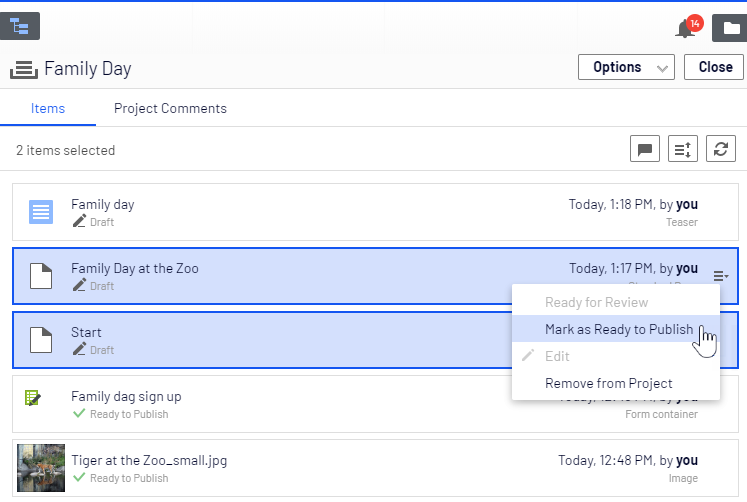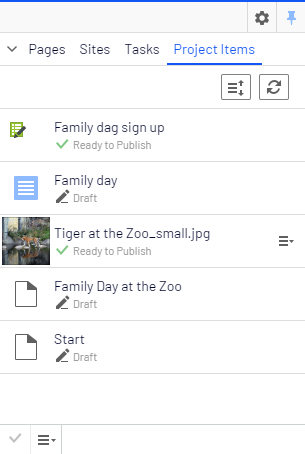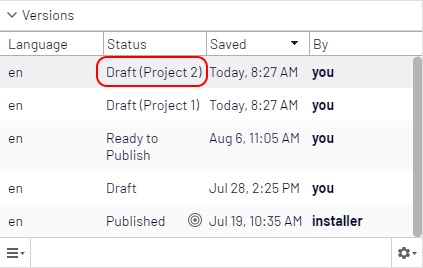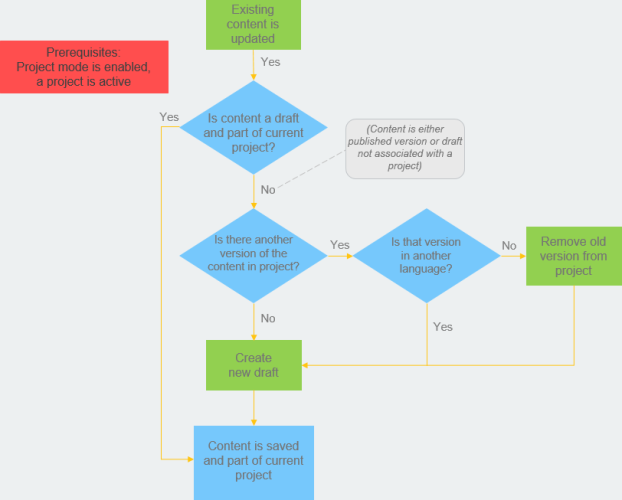 Projects user interface
Projects user interface
Project bar
A project bar is displayed at the bottom of the CMS window indicating if a project is active or not.

When you first access the edit view with the projects feature enabled, no project is selected in the project bar. When you select a project, it is preselected the next time you open the user interface.
If a project is active—that is, is selected in the project bar—all changes (creating a new page or block, updating existing content, uploading an image and so on) are automatically associated with that project.
If you select the option None (use primary drafts), you can work with content items as usual without associating them with any projects.
From the context menu on the project bar, you can create, rename and delete projects.

If you delete a project, associated items are not deleted but are no longer associated with a project.
Project overview
From the projects bar, you can open an overview that displays content items associated with the active project.

The overview shows details such as name, content status, content type, and time and date for latest change of each content item.
Each content item in the overview has a context menu from which you can set the item to Ready to Publish, open it for editing and remove it from the project, providing you have Edit access rights. The context menu button appears when you hover over an item.
You can select multiple items in the overview and remove them from the project or set them as Ready to Publish all at the same time. Common computer mouse and keyboard functionality for selecting multiple items is supported, except for CTRL+A which is not supported.
From Options in the overview, you can publish all items that are set to Ready to publish immediately or schedule them for publishing at a later time.
Show comments opens a view where you can select a project item and see a list of events connected to the item. You can add comments on each event and also reply to comments, see Collaboration between editors.
Use Sort  to order content items for a better overview, and Refresh
to order content items for a better overview, and Refresh  to reload the view if there are multiple editors working on the same project.
to reload the view if there are multiple editors working on the same project.
Project items navigation pane
The project items navigation pane provides quick access to items in the project. Double-click an item to open it.

Each content item in the project items pane has a context menu displayed when you hover over an item; the menu options are the same as those in the project overview. You can select multiple items in the list the same way as in the project overview.
Versioning when working in projects
Add the versions gadget to your user interface if you are working with multiple drafts and projects to see a list of the different versions.
It is only one version of a page that is associated with the project. This means you can have a published version of a page and several drafts, and any one of these versions can be associated with the project. If the associated version is the published version, the project overview displays Published for that item. If it is not the published version, the overview displays Draft, Previously Published, Expired and so on.
The Versions gadget shows you which project each version is associated with, which is especially useful if you are working with multiple projects for the same content:

You can only have one published version, so if you publish another version of the page (that is, a version that is not associated with the project) after the version associated with the project, the project version is not published anymore and therefore set as Previously published in the project overview.
When you open an item and have a project active, Optimizely CMS displays the version associated with the active project. If you open an item and do not have a project active, Optimizely displays the version that is set as primary.
You can see which version is the primary in the versions gadget; the primary version is marked with a target symbol  . The primary draft is not necessarily the latest version. See also: Setting the primary draft.
. The primary draft is not necessarily the latest version. See also: Setting the primary draft.
When the projects feature is enabled, versioning works in the following ways:
| Project 'X' is selected | Result |
|---|---|
| and you create new content from scratch: | The draft is created and added to the active project automatically. Because this is the only version of the content, it is set as the primary draft. |
| and you update existing content: |
Is the content a draft and associated with the active project?
Yes: The draft is saved and still associated with the active project. Whichever version was the primary draft before is still the primary draft. No, the content is a published version or a draft not associated with the active project: A new draft is created and is associated with the active project. The previous version is still the primary draft. If there is a previous draft within the project in the same language, the previous draft is replaced with this new draft as only one version can be associated with a project. The previous draft remains in Optimizely as a draft but is no longer associated with a project. A draft of the same project item but in another language is not replaced as it is viewed as another version of the item. This means that you can have one draft in English and one draft in French of page Z in the project X, but you cannot have two drafts in English of that page. |
| None (use primary drafts) is selected | Result |
|---|---|
| and you create new content from scratch: | The draft is created and set as primary draft. |
| and you update existing content: |
Is the content a draft? It does not matter if the content is associated with a project or not; versioning works the same in this case. Yes: The draft is updated and saved. If it was associated with a project before you edited the draft, it will still be associated with the project afterwards. Whichever version was the primary draft before is still the primary draft. No, the content is not a draft: A new draft is created and is not associated with a project. It is set as the primary draft. If the updated content is a media file and auto publish is turned on, the media is automatically published at this stage. |
